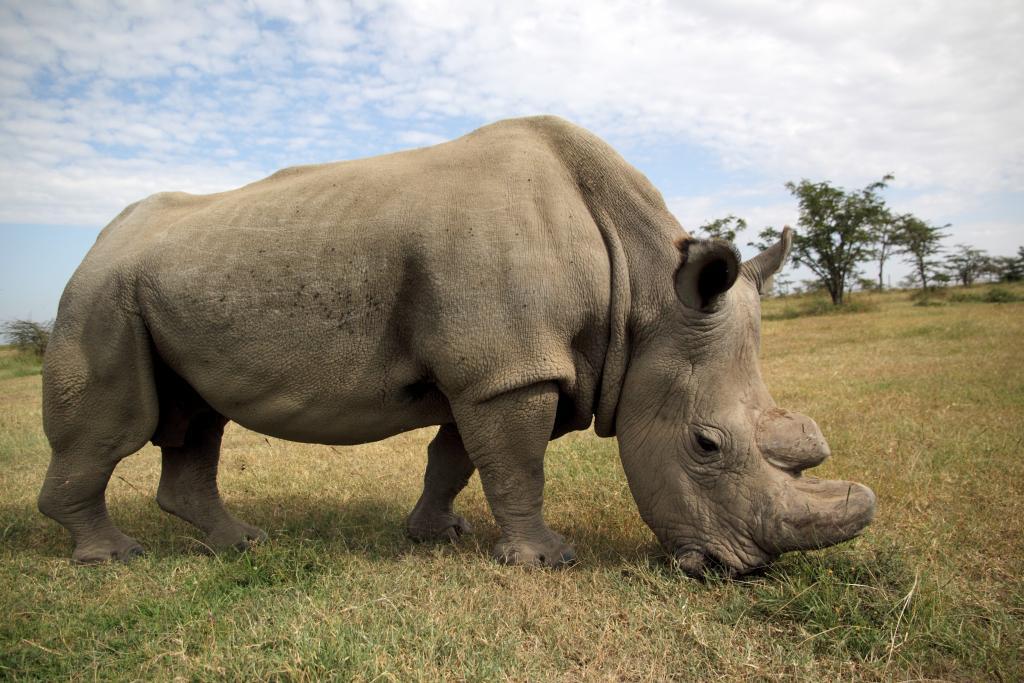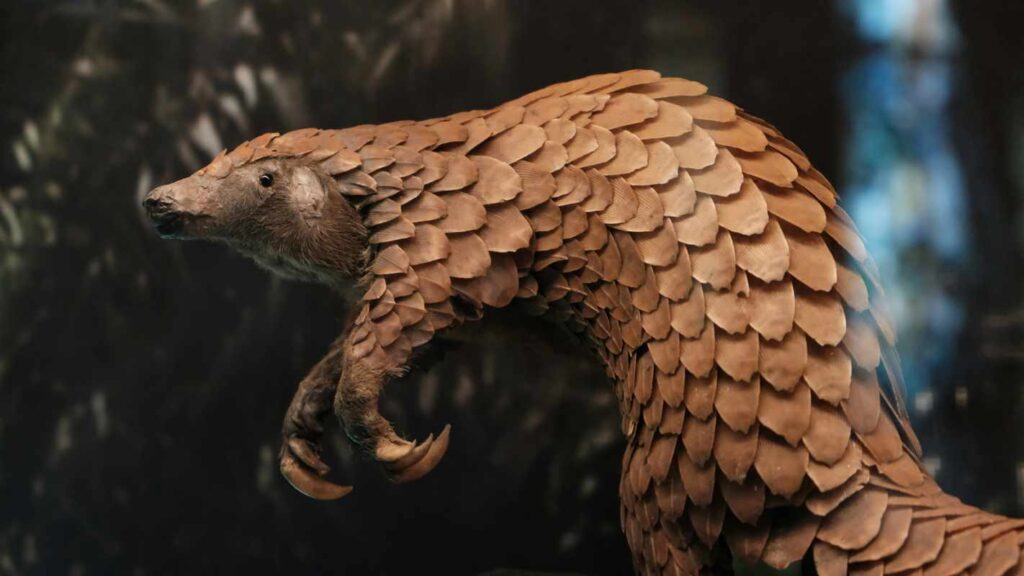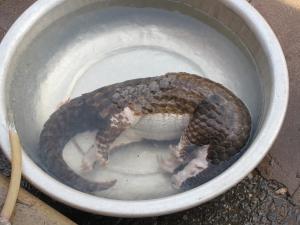

Estimated reading time: 1 minute
Original article updated 16 May 2025
Endangered Species Day, held on the third Friday in May, is a powerful reminder of our collective responsibility to protect the most vulnerable wildlife species before it’s too late.
For Endangered Species Day 2025, we are taking a look at 10 animal species that have been hunted or harvested to the brink of extinction.
In the lush jungles of Borneo, a male orangutan swings effortlessly through the canopy—a habitat his ancestors have known for millennia.
Thousands of kilometres away, a polar bear paddles through thinning Arctic ice, her journey becoming increasingly treacherous as she searches for food across a shrinking domain.
From forest to sea, a similar story unfolds for countless species. Their homes, food sources, and lives are under serious threat, primarily due to human activity.
Endangered Species Day, held each year on the third Friday of May, is a powerful reminder of our responsibility to protect wildlife on the brink.
The animal species hunted and harvested to near extinction
According to global animal welfare organisation World Animal Protection, the crisis facing wildlife is no accident. Humans have hunted, traded, and harvested animals to the edge of extinction.
“Wild animals have become a commodity,” says Audrey Mealia, Global Head of Wildlife at World Animal Protection. “Every day they are being poached from the wild for their bodies to be harvested. Not only is this a major conservation issue—it’s a devastating animal welfare concern.”
Audrey stresses the need for stronger enforcement against illegal poaching and wildlife trafficking: “Pangolins—and other wild animals—belong in the wild.”
In the lush jungles of Borneo, a male orangutan swings from branch to branch, his movement effortless against the dense canopy that has been his ancestor’s home for millennia.
Miles away, in the Arctic’s icy waters, a polar bear navigates shrinking ice floes, her journey getting harder and longer each year in search of food.
It’s a similar story for many animal species globally. Their habitat, food supply, and the animals’ lives have dwindled under an ever-growing human threat.
Endangered Species Day, celebrated annually on the third Friday of May, is a great time to highlight those animal species who are close to extinction.
The world’s 10 most endangered species
1. Vaquita
Natural habitat: Northern Gulf of California, Mexico
Estimated population: Fewer than 10
The world’s rarest marine mammal, the shy and elusive vaquita, is facing imminent extinction due to entanglement in illegal fishing nets. With such low numbers, every individual counts.
2. Javan rhino
Natural habitat: Ujung Kulon National Park, Indonesia
Estimated population: Approximately 76
The Javan rhino, once found across Southeast Asia, now clings to survival in a single protected area. Habitat loss and natural disasters remain key threats.
3. Amur leopard
Natural habitat: Russian Far East and northeast China
Estimated population: Around 100
This solitary and striking big cat is endangered due to habitat destruction and poaching. Conservation efforts have slightly increased numbers, but the species remains at risk.
4. Saola
Natural habitat: Annamite Mountains, Laos and Vietnam
Estimated population: Unknown; critically endangered
Often called the ‘Asian unicorn’, this elusive antelope-like animal was discovered only in 1992. It has rarely been seen in the wild since, and its numbers are unknown but believed to be dangerously low.
5. Pangolin
Natural habitat: Africa and Asia
Estimated population: Critically endangered
Pangolins remain the most trafficked mammals on Earth. Their keratin scales are falsely believed to have medicinal value, and their meat is considered a delicacy in some countries. Eight species are listed as vulnerable to critically endangered.
6. Yellow-eyed penguin
Natural habitat: Coastal New Zealand
Estimated population: Fewer than 3,000
This rare penguin faces threats from habitat degradation, introduced predators, and human disturbance. Conservation projects in places like Dunedin help monitor and protect colonies.
7. Yangtze finless porpoise
Natural habitat: Yangtze River, China
Estimated population: Around 1,000
China’s only freshwater porpoise is threatened by pollution, heavy shipping traffic, and habitat loss. Conservationists fear its fate could mirror that of the now-extinct Yangtze River dolphin.
8. Tapanuli orangutan
Natural habitat: North Sumatra, Indonesia
Estimated population: Fewer than 800
This great ape species, discovered in 2017, is already the most endangered of all orangutans. A proposed hydroelectric dam project threatens their only known habitat.
9. Southern white rhino
Natural habitat: Kenya, East Africa
Estimated population: 2 remaining females
With the death of the last male in 2018, only two females remain under intense human protection. Scientists continue efforts using IVF to bring the species back from the brink.
10. Hawksbill turtle
Natural habitat: Tropical oceans, including Australia’s Great Barrier Reef
Estimated population: Critically endangered
Prized for their colourful shells, hawksbill turtles are heavily hunted. Their nesting sites are also vulnerable to climate change and coastal development.
Why it matters
These animals are more than just species—they’re part of complex ecosystems that affect the entire planet. From pollination to climate regulation, their survival is linked to ours.
Endangered Species Day is not just a commemoration—it’s a call to action. Whether through donations, education, or ethical travel, we can all help turn the tide for wildlife.
👉 Visit World Animal Protection or the IUCN Red List to learn more and get involved.
World Animal Protection have provided us with facts about some of the lesser-known endangered species around the world:


Pangolins are an example of one the most endangered species because of being trafficked almost to extinction.
They are small cat-sized creatures covered in hardened scales that account for 20 per cent of their weight.
There are eight species that mainly occupy Africa and Asia, and they are all considered either vulnerable or critically endangered.
The animals also have the ability to roll up into a ball, creating a hard, spiky, impenetrable sphere that even the jaws of lions, tigers and leopards can’t break.
On the downside, this means humans can capture them as easily as picking up a ball.
Some people believe their scales can stimulate lactation, cure cancer or cure asthma.
The scales can be worth $3,000 per kilogram on the black market.


Yellow-eyed penguin
Natural Habitat: Dunedin, New Zealand
The yellow-eyed penguin, native to New Zealand, is now the rarest penguin in the world due to deforestation and predators.
Known for their distinct yellow eyes, these animals are tall and have a pale-yellow band of feathers across the nape of their eyes.
Its distinct markings make them one of the most unique penguin species.
Wildlife lovers can even catch a glimpse of them on the Nature’s Wonders wildlife tour in Dunedin, an award-winning conservation project where travelers observe animals in their natural habitat.
Travellers can’t get too close or touch the penguins.


Natural Habitat: Asia
The Saola is an extremely rare mammal on the list.
Although known as the ‘Asian unicorn’, Saolas actually come from cattle and goats.
The first photo of one was taken in 1999 despite the species being first discovered in 1992.
The Saolas are nearly extinct because of loss of habitat.
Those remaining occupy the Animated Mountains of Vietnam and Laos.
They are one of the most spectacular zoological discoveries of the 20th century.
The Vaquita
Natural Habitat: Gulf of California
The vaquita hails from the Gulf of California.
Locals call them the little pigs or cows of the sea.
There is only approximately six to 22 vaquita porpoises remaining.
The population in 1997 was 600.
Conservationists have invested millions of dollars into the plight to keep the species alive, but they have been under threat from illegal fishing.
Illegal gillnets cause a lot of harm to Vaquitas.
The species has a kind, shy, and gentle nature.
Southern White Rhino
Natural Habitat: Kenya, East Africa


Southern and central Africa are home to two of the last remaining adult female southern white rhino.
Though prior to the first artificially inseminated southern white rhino being born, this species was critically extinct due to the death of the breed’s last male.
Their larger size and squared upper lip differentiate them from the common black rhino.
The Ol Pejeta Conservancy in East Africa even offers travellers the rare opportunity to see the two final adult white rhinos left in existence, Nahjin and Fatu, in their natural habitat.


Head to World Animal Protection’s website for more information, as well as great educational content about endangered animals and more!
What is Endangered Species Day?
Endangered Species Day is observed annually on the third Friday of May. The day is about to raising awareness about the critical status of species nearing extinction, and the urgent need to conserve their habitats.
It also encourages global action and education, highlighting the significant efforts required to protect the biodiversity that is vital for our planet’s health and future.
The top ten endangered species
The World Wildlife Fund (WWF) has been at the forefront of global conservation efforts, striving to protect endangered species and their habitats.
Through rigorous research and innovative strategies, WWF works to mitigate the threats of habitat destruction, poaching, and climate change. Their comprehensive approach involves on-the-ground conservation, advocacy, and community engagement to ensure a sustainable future for wildlife.
Here are some of the most critically endangered species identified by WWF that require immediate action and protection:
Javan Rhinos
Found only in Ujung Kulon National Park, Indonesia, Javan rhinos number around 75. Threats include habitat loss and poaching.
Amur Leopard
With about 100 individuals in Russia and China, the Amur leopard faces habitat fragmentation and poaching.
Sunda Island Tiger
Approximately 600 remain on Sumatra, Indonesia. They are endangered due to habitat loss and poaching.
Mountain Gorillas
Over 1,000 live in Congo, Rwanda, and Uganda. Threats include habitat encroachment and disease.
Tapanuli Orangutan
With fewer than 800 individuals, they are the most endangered great apes, residing in North Sumatra, Indonesia.
Yangtze Finless Porpoise
Critically endangered, fewer than 1,000 remain in the Yangtze River, facing pollution and habitat degradation.
Black Rhinos
Approximately 5,630 remain, primarily in Kenya, Namibia, South Africa, and Zimbabwe, threatened by poaching.
African Forest Elephant
Populations have declined by 86% due to poaching and habitat loss, primarily in Central Africa.
Sumatran Orangutan
Less than 14,000 survive, with threats from logging, agriculture, and the illegal pet trade.
Hawksbill Turtles
Critically endangered due to accidental capture in fishing gear, habitat loss, and illegal trade.
For more details, visit the WWF Endangered Animals page
